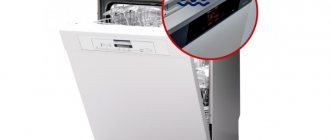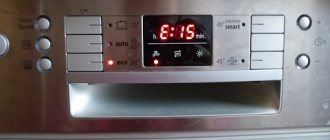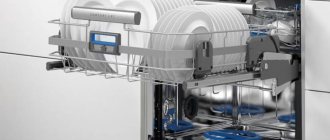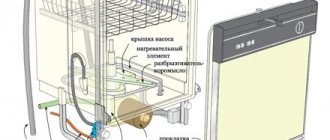Basic elements
All dishwashing devices have the same parts, which are interchangeable on many models.
To see them, you need to remove the case by unscrewing a few screws. The interior consists of the following parts:
- Circulation pump. It is combined with the PMM engine and serves to pump and supply fluid to the rocker arm sprayers.
- Drainage pump (DP). It is necessary to drain water at the end of the process.
- Water pump. It is attached to the engine housing and serves to remove liquid, pieces of food and fat from the filter.
- The heater is flow-through. Provides heating of the liquid to the temperature specified by the program. Installed inside the main LP pump.
- PMM control board. This is the main “brain” that supports the operation of all components of the device.
- Filler hose. Serves for intake (receipt) of working fluid into the unit tank. It is equipped with a leakage protection unit.
- Drain hose. It has several pipes for draining water from the inside of the unit and discharging contaminated liquid into the sewerage system.
- Pressostat. This sensor is designed to measure the water level in the PMM and the pressure in the tubes.
- Ion exchanger. This is a reservoir with a special resin necessary to soften the working fluid.
- Cleaning filter. It is installed at the inlet hose (inlet) of the “dishwasher” and protects the device from rust, sand and other fine elements from the water supply entering its system. It is designed to retain any type of contaminant, since perfectly clean water must flow into the engine.
- Hoses and clamps. Ensure unhindered passage of the working environment between nodes.
- Electrical wiring is necessary for the operation of the device.
- Noise insulation - muffles the sounds of running motors and pumps.
- Water collector.
When examining the PMM from the side of the tank, the following elements become visible:
- Sprinklers (in everyday life - rocker arms) are lower and upper, through which water is thrown into the machine. They rotate during the washing process and spray water onto the dishes.
- Baskets (stainless steel mesh) for storing dishes and cutlery.
- Double filter unit. It consists of two containers with a very fine mesh, one of which is installed at the bottom of the PMM. The second filter is located on top of the first.
- Salt compartment.
- Containers intended for detergents (located on the door).
- Rubber sealing the tank.
How does a dishwasher work?
Before you start using the washing machine in the kitchen, it must be connected to communications: power supply, water supply and sewerage. Mostly, this work is performed by craftsmen, but if you have the tools and skills, you can connect the PMM yourself. You can read how to do this here.
To operate the dishwasher, the following consumables are required:
- specially prepared salt to soften water (remove salts from it);
- detergent;
- rinse aid
Using a special type of salt that softens water is a necessary condition for high-quality dishwashing. When using tablets that combine all three components, salt is still added to the container.
Consumables for dishwashersSo, let's look at the operating principle of a dishwasher. Its work occurs in several stages:
- Dirty dishes are loaded into baskets located in the working chamber. It should be noted that the dishes must be placed strictly according to the rules, otherwise they will not be washed properly.
- The machine is turned on and its operating program is selected. For example, for kitchen utensils that are too dirty, a pre-soaking mode is selected, as well as a high water heating temperature.
- Through the inlet hose and inlet valve, water begins to flow into the designated reservoir. The liquid is mixed with salt and softened. At the same time, the water is heated to the temperature specified by the program. Some models of household appliances from Bosch, Siemens, Electrolux and other well-known manufacturers have the ability to connect not only to cold, but also to hot water. Despite this, experts do not recommend connecting hot water, since the PMM will still heat it itself.
- Once the liquid has reached the desired temperature, it is mixed with detergent and the pre-soak cycle begins. The circulation pump supplies the mixture in small portions to the sprinklers (hereinafter also referred to as sprayers). Under liquid pressure, the sprayers begin to rotate and distribute the washing mixture through the nozzles over the entire surface of the dirty dishes. Water softens dried food residues. Once this task is completed, the primary rinse mode is activated. The pump intensively supplies liquid to the nozzles. Under the influence of strong pressure, most of the soggy dirt residues are washed off from the kitchen utensils.
- The dirty liquid is not drained down the drain, but passes through a filter, being cleaned for reuse. This allows you to save resources. Detergent is added again to the purified water. A more concentrated mixture is again sprayed over the surface of the dishes in a large volume, completely washing away the remaining dirt. Only after reuse is the dirty liquid drained into the sewer using a pump.
- For the final rinsing of the kitchen utensils, the inlet valve is opened again and clean water is drawn into the reservoir. First, the container is rinsed with a small amount of it, and then the reservoir is filled for the final stage. The drainage pump delivers liquid under high pressure to the spray nozzles, which allows you to completely wash away any remaining detergent and dirt. Depending on the selected program, rinsing can be carried out once or twice. After the process is completed, the drain pump removes the waste water into the sewer.
- The final stage is drying the washed dishes. Depending on the design of the PMM, kitchen utensils are dried forcibly or in a natural (convection) mode. The forced option provides that heated air is pumped into the chamber and quickly dries the dishes. Natural drying takes longer.
Forced turbo drying in dishwashers
Now you know how PMM washes dishes. As you can see, there is nothing complicated about this. The main feature is that hot soft water, diluted with a detergent, can wash away even the oldest and most dried dirt.
We invite you to see with your own eyes from the inside what happens in the dishwasher chamber when it is working:
Dishwashers are increasingly winning the hearts of buyers in Russia and neighboring countries. As you can see, anyone can handle their maintenance, and the benefits and time savings are enormous.
What to do if the dishwasher doesn't work well?
If you still managed to start the unit, but it is obvious that it is not working correctly or is not performing its functions, the closest attention should be paid to the following points:
- Knocks and other extraneous sounds when equipment is operating
The integrity of the nozzle bearings should be checked. The bearings of the main or drain pump unit may also knock. The first works periodically, pumping water into the system, the second - at the end of each cycle.
- Water does not enter the working chamber
If the filter and water supply hose have nothing to do with it, most likely the culprit is a broken inlet valve that needs to be replaced.
Dishwasher inlet valve
- Pressure switch does not work
You need to remove the terminals from this part and clean the pipe to which the plastic pressure tube fits - a working switch, when triggered, makes a soft click.
- The machine stops mid-cycle
The reason for this is most often a faulty pump. But first you should check the recirculation filters, water intake path, water heater or thermostat.
Dishwasher circulation pump
- Dishes are washed with cold water
Most likely, your machine does not have a temperature sensor, so its programmer did not notice that the heating element or heating automation was out of order. In this case, you will have to replace the broken electronics, which is recommended to be done at a service center.
Types of dishwashers
The main difference between a domestic and commercial dishwasher is the way it is loaded. In a household unit, alternate loading is used, that is, for each cycle of operation of the machine, a certain amount of dirty dishes is loaded.
Industrial dishwashers use in-line loading, where dirty plates or trays are continually added to a continuously moving conveyor (with dish grabbers). In addition, many industrial designs filter and reuse used water, allowing for more economical operation.
Dishwasher device
The design of a dishwasher is not complicated. Any such unit consists of several elements: 1) Housing. As a rule, plastic or assembled from stamped metal sheets; 2) Electronic control unit. Electronic control board with microcontroller. Allows the user to set the dishwashing mode. Controls all processes in the machine; 3) Electric motor. Activates the water pump and sprinklers (rocker arms); 4) Pump pump. Provides liquid under pressure to the spray nozzles; 5) Water spray system. It is a rotating block of injectors (rocker arms). When spraying, the rocker arms change the angle of water supply to cover the entire surface of the dishes; 6) Drying system. A powerful fan (hair dryer) forces air through a heating element onto the surface of the dishes (some models use condensation drying - in fact, the dishes dry on their own, due to the heat accumulated during the washing process).
Dishwasher cycles
The entire operation of the machine is controlled by a special electronic control unit. The microprocessor monitors the readings of many sensors (temperature, water level, door closing, etc.) and sets the operating mode of the device. The washing process consists of several stages:
- Water inlet. Water (usually cold) begins to flow into the machine from the water supply when the solenoid valve opens. The amount of incoming liquid is monitored by level sensors. Some models allow the supply of both hot and cold water; such machines are more economical, since they do not consume electricity for heating. After the solenoid valve, the water is softened by a special device (usually an ion exchanger with resin). Soft water washes dishes better and does not leave limestone deposits on machine parts;
- Heat. The water entering the machine is heated using heating elements (heating elements) in batches or continuously (in a flow-through heater);
- Supply of cleaning agent. Water heated to a certain temperature (determined by the washing mode) is mixed with detergent (supplied from a chemical container). The supply time and amount of cleaner is determined by the washing program;
- Washing dishes. The electric motor drives the pump, which supplies hot water (mixed with the purifier) under pressure to special spray units. Rotating at different angles, the sprayers clean the entire surface of the dishes with jets of water. Some dishwasher models pre-clean dishes from heavy soiling by supplying steam. Steam is generated in a special device - a steam generator. At the end of the wash, the dirty water is automatically drained into the sewer (during the cycle itself it circulates in a circle);
- Rinse. After completing the washing process, the dishes are cleaned of any remaining cleaning agent using jets of cold water under pressure. This process can take a certain time (cheaper models) or be controlled by special sensors for the cleanliness of dishes and the level of wastewater contamination (expensive models).
Types of drying dishes
There are the following types of drying dishes: 1) Condensation drying. The most common type of drying, widely used in inexpensive household models. The washed dishes are doused with hot water, which evaporates and condenses on the inner walls of the machine, and then flows down the drain. This process is very time-consuming. 2) Turbo drying. The process occurs through continuous exposure of washed dishes to hot air. The air is pumped by a special fan, then, passing through the heating element, it heats up and enters the compartment for dishes. Turbo drying allows you to dry dishes in the shortest possible time, without leaving streaks on them. Dishwashers equipped with this drying mode are quite expensive, due to the use of additional devices. In addition, they consume a lot of electricity.
A source of information.
Dishwasher device
The design of household dishwashers is in many ways similar to the design of washing machines. The main difference is that the dishwasher does not have a rotating drum and the presence of a number of specific functions that ensure the dishwashing process.
Types of household dishwashers in the photo
[wonderplugin_gridgallery id=”18"]
You can get acquainted with the internal structure of the dishwasher by opening its front wall. The list of main units and components of the unit includes:
- Control Panel.
- Board with processor.
- Electric motor.
- Dispenser.
- Dryer air path.
- Turbofan.
- Upper and lower baskets.
- Cutlery basket.
- Upper and lower rocker arms.
- Pressure pump.
- Filter system and softener.
- Drip pan and drainage.
- heating element.
- Counterweight.
- Capacitor.
- Water supply valve.
- Upper and lower (side) sprayers.
- Container for detergents.
- Float regulator.
- Ion exchanger.
- Container for salt.
Dishwasher interior
The basis of the dishwasher is a sealed metal case, coated on the inside with a stainless steel compound, insensitive to temperature fluctuations and the aggressive effects of detergents and equipped with sound and thermal insulation. The control panel is located on the front wall of the machine. It consists of a timer (microcontroller), control buttons and an indicator display.
Dishwasher control panel
Spray blocks (impeller) consist of a system of tubes and spray nozzles. Through them, heated water with detergent is supplied under pressure into the interior of the machine, which ensures high quality cleaning and washing of dishes.
Dishwasher impeller sprayer
The dishwasher float switch is the main means of protection against leakage. The drainage unit has a design similar to the drainage in washing machines.
And one of the main components of the dishwasher is the water pump, which is installed together with the electric motor. The filtration system is no less important - it serves to catch food debris and other debris.
How do PMMs differ?
The above parts are standard components of any dishwasher. Depending on the manufacturer’s brand (Electrolux, Ariston, Bosch, Hansa), the equipment can be supplemented with new functions and elements:
- Heat exchanger. Its operation allows you to quickly dry dishes after a wash cycle. It is a reservoir of water that releases heat and saves energy.
- Additional heater, fan. Serve as the basis for turbo drying. The heating element heats the air, and the fan disperses it throughout the chamber. As a result, after a few minutes you take out dry dishes.
- Turbidity sensor. Determines the purity of water in the tank. The appliances will be rinsed repeatedly until the water runs clear. Therefore, the plates come out perfectly clean.
- Rinse aid and salt sensor. As soon as the funds are running low, the sensors will report this and you will be able to replenish the stock in time.
- Sensor Dry. The new development is found in expensive PMM models. This is a sensor that scans the ambient temperature and adjusts it accordingly in the hopper.
- Container with zeolite. Another drying technology. By absorbing moisture, the mineral generates heat, which allows the devices to dry. Interestingly, the shelf life of the mineral is long, it lasts for the entire lifetime of the dishwasher. At the same time, the equipment does not consume electricity.
- Water hardness sensor. The sensor readings serve as a signal to select the optimal washing program. Can only be found in expensive PMMs.
- Beam on the floor. Convenient function for determining the end of a program. Depending on the type, this may simply be a beam or an indication of the time until the end of the cycle (Bosch, Siemens).
Separate spray nozzle for baking trays and glass holder. Components can come with the equipment (Indesit, Burning) or be purchased separately, as in the Beko, Ariston equipment.
In addition, equipment may differ in the material of parts and components. For example, baskets can be made of plastic and metal, their holders can be folding
Rocker arms are most often made of plastic, so you need to install the plates carefully so as not to damage the part. Rare models have metal nozzles
Operating rules
Even if the design of the dishwasher provides for the supply of hot water, you still should not connect it to the hot water supply. Firstly, the quality of hot water is lower than cold water, so the filters clog much faster. Secondly, components used for hot water fail faster than those used for cold water. Therefore, you will have to change hot water hoses much more often.
When using a dishwasher, you can save energy. To do this, wait until the washing procedure is completed and turn off the machine. Open the door and wait for the dishes to dry naturally. Thus, by not turning on the electric heating elements during drying, significant savings can be achieved. This operation is performed if there is no need to quickly complete washing.
How efficient are dishwashers?
Contrary to popular stereotypes, dishwashers can easily handle any amount of dishes and any dirt. The principle of operation of a dishwasher is that the equipment can operate at any power. If a person, washing dishes with his hands, cannot accurately calculate his efforts and the required amount of product sufficient to wash a given amount of dishes, while the machine is configured for different cycles and copes with any type of dirt. Due to the use of special alkalis, the dishwasher mixes them with water. The finished substance dissolves dirt, after which it rinses the dishes, drains the water and begins the drying cycle.
What items can be washed in a dishwasher?
Ceramic and metal objects can be washed in any mode. Aluminum is a rather capricious substance and contact with hot water and substances used for washing dishes can have a detrimental effect on it. In this case, there is a high probability of corrosion stains appearing. We strongly do not recommend washing aluminum spoons, pots, plates and meat grinders in the dishwasher, since in this case there is a high probability of dark spots appearing on the surface of the dishes. After this, the use of utensils becomes harmful - aluminum particles entering the body have a detrimental effect on internal organs.
If you do wash your aluminum cookware in the dishwasher and find dark spots, it’s time to treat it. Any means will do here: from toothpaste to rust solvent. The safest way is to keep the dishes in a soapy solution. Add a few drops of liquid tar soap to warm, but not boiling, water. Afterwards, dip the darkened objects into the solution. There's no time limit here, so you don't have to worry about adding too little or too much soap to the water.
The method of rubbing with soda is no less popular. A thin layer of baking soda is applied to the damp surface and, after half a minute, you can begin to rub. Remember: under no circumstances boil dishes in a soda solution. This can only worsen the condition of aluminum cookware and accelerate the processes of oxidation and corrosion.
Therefore, to avoid such situations, it is better to wash aluminum items by hand. It may take you some time, but you can avoid corrosion and extend the life of your cookware.
Description of the processes occurring in the dishwasher
Despite people’s preconceptions that a dishwasher is a very complex and capricious device, let’s say that this is absolutely not the case. A “dishwasher” is a technically simple unit, and understanding the principles of its operation is not at all difficult. Once we install the dishwasher in place, connect it to the water supply, sewer and electrical network, and then load the dirty dishes, a number of interesting processes occur.
- First, we set the washing program, press the start button, and then go about our business.
- Without us, the washing cycle begins, which is carried out without human intervention. The control unit issues a command, the water intake valve opens and water flows into a special container.
- Next, water and salt are mixed. Salt softens water and makes dishwashing more efficient. At the same time, the control module activates the heating element. Further processes do not start until the water in the chamber is heated to the required temperature (the temperature is set by the user).
- Further actions of the dishwasher depend on the set program. Suppose the dishes we loaded were very dirty, and we turned on the soak mode first. The control module commands the circulation pump to supply a mixture of water and detergent in very small portions to the spray arm, which begins to spray drops onto dirty dishes for a long time, to ensure the effect of liquefying dried-on dirt.
- Next, the primary rinse is activated. Now the circulation pump delivers the mixture to the sprinkler, and the remaining food is washed off under pressure. The main spray arm is located at the bottom of the hopper under the lower dish basket. It not only sprays water and detergents, but also rotates, making it possible to cover all the dishes.
- Subsequently, the water that was used for rinsing is not drained, but passes through coarse filters and returned to the tank. There, the system increases the concentration of the detergent and re-sprays the dishes, which allows you to remove most of the dirt from them.
- Next, the system gives a command to drain the waste water. Dirty water is pumped out by the drain pump, in return a little water is poured in, which rinses the tank from the inside, and then it is drained into the sewer.
- Now the valve opens and clean water is poured into the tank to rinse the dishes from any remaining dirt and detergent. The algorithm is simple: clean water under significant pressure is supplied by a circulation pump to the sprinkler, and it washes off the remaining detergent from the dishes. The device can repeat the process of rinsing dishes, which increases the program execution time.
- Next, the control module gives a command to drain the waste water, and the pump removes water from the tank into the sewer system.
- Now it's drying time. If the dishwasher has a forced drying function, then a special fan forces hot air, heated by a heating element, into the hopper with dishes, and they dry out very quickly. If there is no such function, then drying is carried out naturally in convection mode.
We have described, in general terms, what happens inside the dishwasher. Our description may seem complicated to you, then you can watch a video that demonstrates the operation of the dishwasher. Or you can find and watch the video and compare it with our description. Whatever you do, as long as you get an idea of how dishwashers work, you will spend little time on this.
Problems in the operation of the dishwasher, ways to solve them
It often happens that a program starts, the indicator lights up, water is poured into the machine, and it works for the required time. But then it turns out that the dishwasher doesn’t wash the dishes, but just hums. This can happen due to a clog in the filter at the bottom or in the nozzles. Simply rinse the filter or clean the nozzles with a toothpick. This can also be caused by a breakdown of the circulation pump. In order to repair it, you need to disassemble the device. It is better to call a specialist for this. The problem may also lie in the motor winding. You need to check the unit with a multimeter for short circuits or network breaks.
- If water overflows in the machine, then its water sensor is broken. It's at the bottom. It must be replaced with a new one.
- And if water fills in when the machine is turned off, then the solenoid valve needs to be replaced.
- If too cold water is poured into the machine, and a special sensor reports this, you need to check the serviceability of the heating element, the correct pressure in the chamber and the operation of the sensor itself.
- If water does not drain from the device, the drain pump may be broken. And if some of the water leaves, but some remains, then you need to figure out how to connect the hose. Also make sure there is no blockage in the drain pump.
- The dishwasher can shock you if there are cracks or damage to the heating element. Inspect it and replace if necessary.
- If the dishwasher does not pick up detergent, then you need to clean the nozzles and check the water pressure.
- The fact that the device began to make a lot of noise was due to the bearings and electric motors. You also need to check the seal.
- Water leakage can be caused by damage to the connections, pipe, hoses, side tank or door seal.
Control method
Modern models of dishwashers are electronically controlled. But among the wide range you can also find mechanical elements. The most convenient to use options are those with a display and touch keys. However, their disadvantage is that they only respond to the warm touch of the fingers. But this minus is practically not taken into account when purchasing.
PHOTO: naahq.org Touch control dishwasher with backlit buttons
As for the mechanical buttons, which must be pressed forcefully to start the mode, they are short-lived, since their mechanism often breaks down. Also, due to moisture and dust, such keys may no longer function properly.
Related article:
Distinctive features of some dishwasher models
Some dishwashers have distinctive features. For example:
- Availability of a heat exchanger. This significantly reduces energy costs during drying, but takes time.
- Availability of a sensor. It determines how clean the water entering the machine is.
- The presence of a sensor that determines whether there is detergent.
- The presence of a drying sensor. It determines the level of dryness and humidity of washed dishes.
- Availability of fasteners for fragile dishes and glasses.
- Availability of a turbo drying system. It provides ultra-fast drying of dishes.
- The presence of backlight when opening the door.
- Durable transparent glass. Used as a decorative element.
- Projecting on the floor information about the remaining time.
You can additionally wash root vegetables in the dishwasher without using detergent. It is possible to wash various combs, rubber shoes, children's toys, and even cook food by simmering or steaming.
The importance of using salt correctly
When using PMM, it is necessary to understand the difference between sodium salt for regeneration and detergent compositions. These products are poured into individual containers and perform different functions.
So, the detergent is poured into a container on the lid, and the salt is poured into a special compartment at the bottom of the chamber.
For convenience, you can buy tablets that already contain everything you need. They are installed in the PMM hatch and provide the required amount of salt during washing.
If the water is too hard, the available volume may not be enough. In this case, the use of a salt ion exchanger is mandatory. Otherwise, the machine will not work for a long time.
The purpose of the salt is to soften the water entering and remove deposits from the heater. In addition, the presence of salt protects cutlery from the appearance of a white coating.
The dishwasher is equipped with an ion exchanger with a resin consisting of NaCl. The water entering the machine is passed through this unit.
Here a chemical transformation occurs, namely the replacement of K (potassium) and Mg (magnesium) with Na (sodium) ions. Thanks to this feature, the appearance of scale in the PMM and stains on the surface of the dishes is eliminated.
Once the exchanger runs out of sodium, it needs to be renewed. However, the use of table salt for these purposes is prohibited.
The only exception is the EXTRA product, which is produced in the form of large crystals. But it is better to give preference to special formulations with sodium chlorine.
The time for which salt reserves last depends on the PMM settings. In some devices, this parameter can be configured independently. After this, you need to control the composition of the incoming liquid and change the previously established characteristics.
To avoid such difficulties, it is better to choose a dishwasher model that has a built-in sensor.











